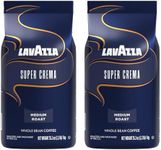Buying Guide for the Best Espresso Beans
Choosing the right espresso beans is essential for making a delicious cup of espresso at home or in a café. The beans you select will determine the flavor, aroma, and overall experience of your espresso. It's important to consider your personal taste preferences, how you plan to brew your espresso, and how fresh you want your beans to be. Understanding the key characteristics of espresso beans will help you make a choice that matches your needs and ensures a satisfying coffee experience.Roast LevelRoast level refers to how long and at what temperature the coffee beans have been roasted. This is important because it affects the flavor, aroma, and body of your espresso. Light roasts tend to have brighter, more acidic flavors and preserve more of the bean's original characteristics, while medium roasts offer a balance of acidity and body, and dark roasts provide a bolder, more robust flavor with less acidity. If you enjoy a strong, traditional espresso taste, you might prefer dark roasts. If you like more nuanced, fruity, or floral notes, a lighter roast could be better. Think about what flavors you enjoy in coffee and choose a roast level that matches your taste.
Bean OriginBean origin refers to the country or region where the coffee beans were grown. This is important because the climate, soil, and altitude of a region can greatly influence the flavor profile of the beans. For example, beans from Latin America often have bright, citrusy notes, African beans can be fruity or floral, and Asian beans might be earthier or spicier. If you prefer certain flavor notes, look for beans from regions known for those characteristics. Trying beans from different origins can help you discover what you like best.
Blend vs. Single OriginEspresso beans can be either blends (a mix of beans from different origins) or single origin (beans from one specific place). Blends are important because they are often crafted to create a balanced and consistent flavor, which is popular for traditional espresso. Single origin beans highlight the unique flavors of a specific region, which can be more adventurous and distinctive. If you want a classic, reliable espresso, a blend might be best. If you enjoy exploring unique flavors, try single origin beans.
FreshnessFreshness refers to how recently the beans were roasted. This is important because coffee beans start to lose their flavor and aroma soon after roasting. Fresh beans will give you a richer, more aromatic espresso. When choosing beans, look for a roast date on the packaging and try to use them within a few weeks of roasting. If you drink espresso often, buying smaller amounts more frequently can help ensure you always have fresh beans.
Grind SizeGrind size is how finely the beans are ground, which is crucial for espresso because it affects how water flows through the coffee and extracts flavor. Espresso requires a fine grind, but some beans are sold pre-ground while others are whole. Whole beans are important because grinding just before brewing preserves freshness and flavor. If you have a grinder at home, choose whole beans. If not, make sure to buy beans ground specifically for espresso machines.
Processing MethodProcessing method refers to how the coffee cherry is removed from the bean after harvesting. This is important because it can influence the flavor and body of the espresso. Washed (wet) processing tends to produce cleaner, brighter flavors, while natural (dry) processing can result in sweeter, fruitier notes. Honey processing is somewhere in between. If you like clean, crisp espresso, look for washed beans. If you prefer sweeter, more complex flavors, try natural or honey processed beans.















